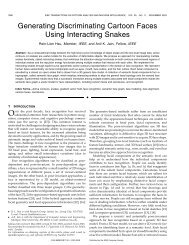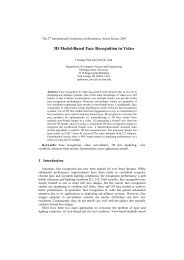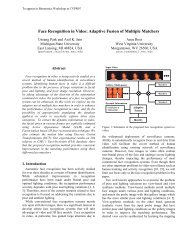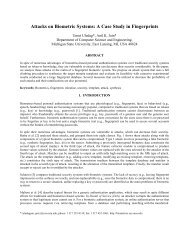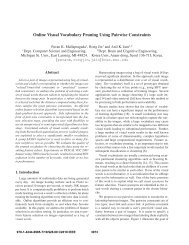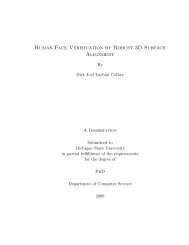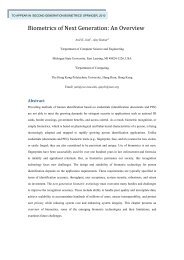Face Detection and Modeling for Recognition - Biometrics Research ...
Face Detection and Modeling for Recognition - Biometrics Research ...
Face Detection and Modeling for Recognition - Biometrics Research ...
Create successful ePaper yourself
Turn your PDF publications into a flip-book with our unique Google optimized e-Paper software.
esult in different recognition approaches. Extensive reviews of approaches to face<br />
recognition were published in 1995 [37], 1999 [31], <strong>and</strong> in 2000 [38].<br />
A workshop<br />
on face processing in 1985 [91] presented studies of face recognition mainly from the<br />
viewpoint of cognitive psychology. Studies of feature-based face recognition, computer<br />
caricatures, <strong>and</strong> the use of face surfaces in simulation <strong>and</strong> animation were summarized<br />
in 1992 [49]. In 1997, Uwechue et al. [92] gave details of face recognition based on highorder<br />
neural networks using 2D face patterns. In 1998, lectures on face recognition<br />
using 2D face patterns were presented from theory to applications [36]. In 1999,<br />
Hallinan et al. [93] described face recognition using both the statistical models <strong>for</strong><br />
2D face patterns <strong>and</strong> the 3D face surfaces. In 2000, Gong et al. [94] emphasized<br />
the statistical learning methods in holistic recognition approaches <strong>and</strong> discussed face<br />
recognition from the viewpoint of dynamic vision.<br />
The above studies show that the face recognition techniques, especially holistic<br />
methods based on the statistical pattern theory, have greatly advanced over the past<br />
ten years. <strong>Face</strong> recognition systems (e.g., <strong>Face</strong>It [1] <strong>and</strong> <strong>Face</strong>Snap [2]) are being used<br />
in video surveillance <strong>and</strong> security monitoring applications. However, more reliable<br />
<strong>and</strong> robust techniques <strong>for</strong> face recognition as well as detection are required <strong>for</strong> several<br />
applications. Except <strong>for</strong> the recognition applications based on static frontal images<br />
that are taken under well-controlled environments (e.g., indexing <strong>and</strong> searching large<br />
image database of drivers <strong>for</strong> issuing driving licenses), the main challenge in face<br />
recognition is to be able to deal with the high degree of variability in human face<br />
images. The sources of variations include inter-subject variations (distinctiveness of<br />
individual appearance) <strong>and</strong> intra-subject variations (in 3D pose, facial expression,<br />
39



